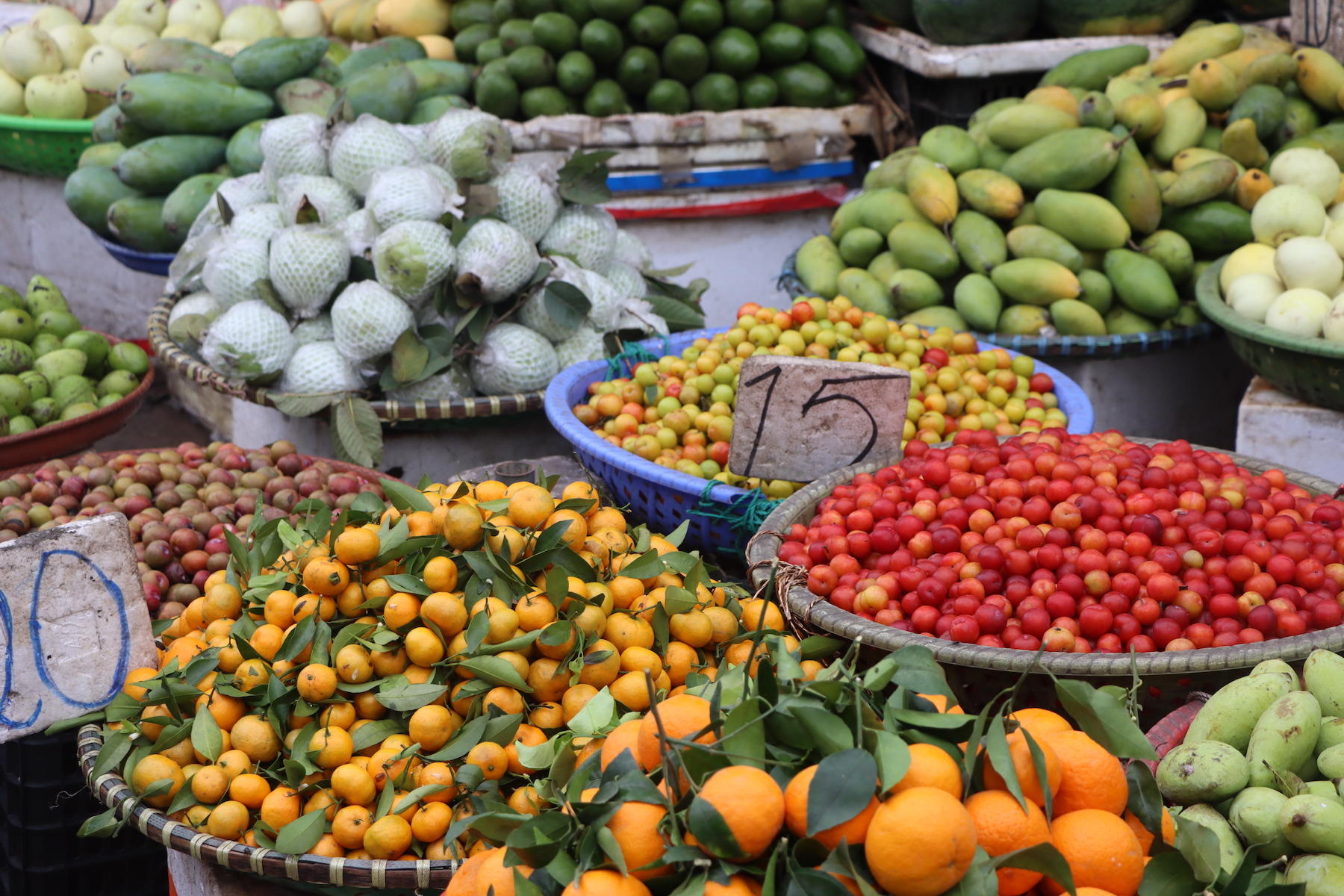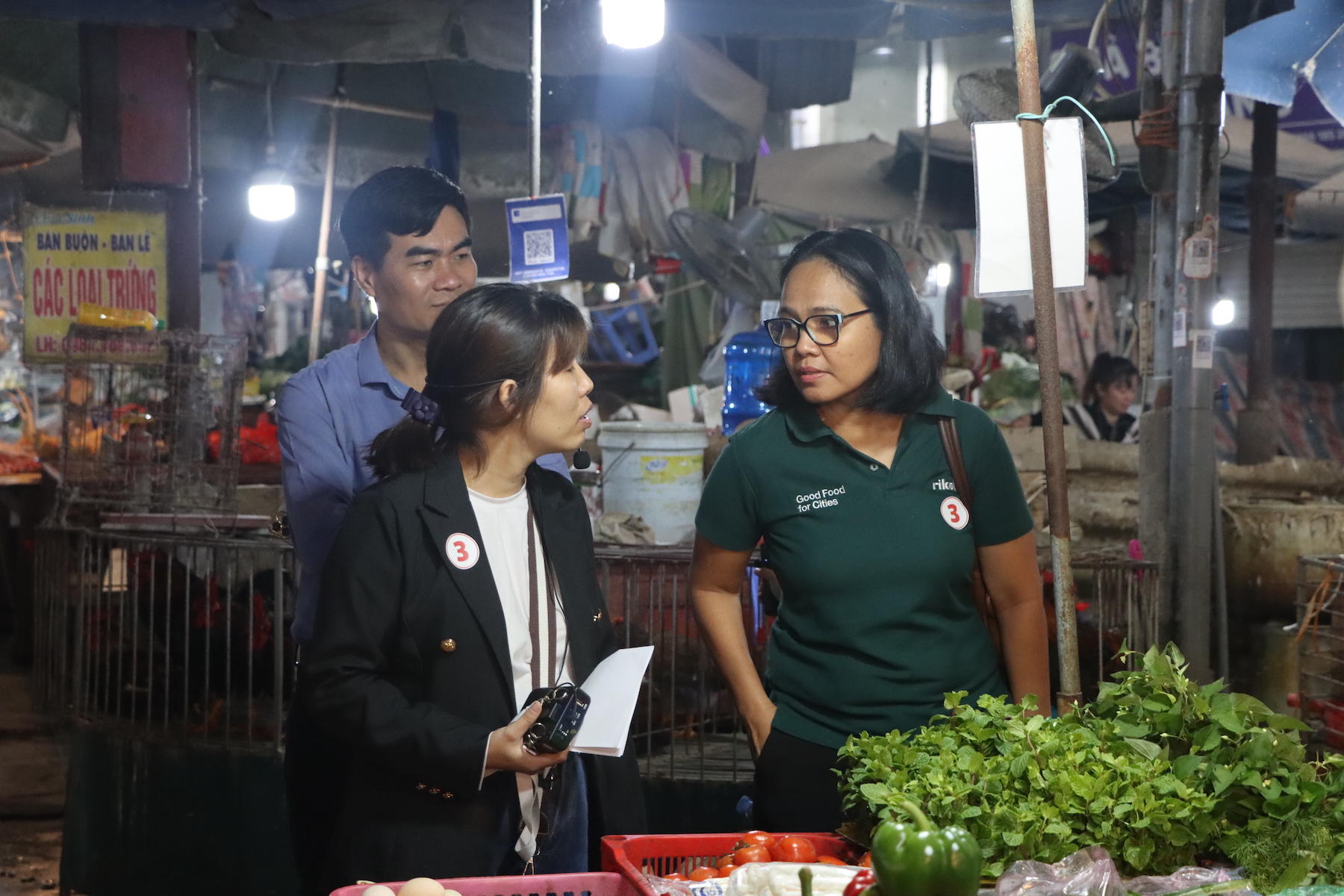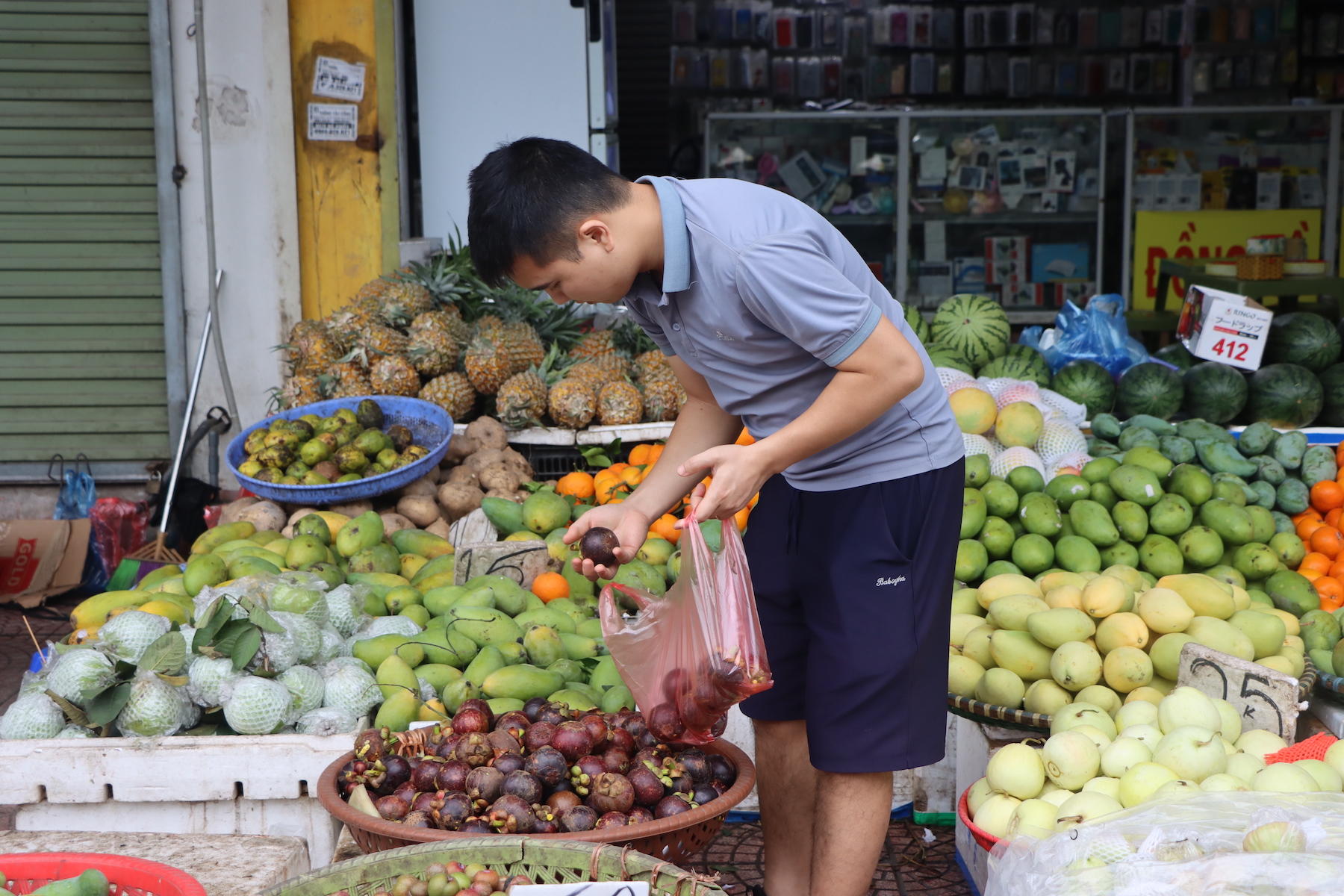From the Field Piecing together the food systems puzzle through data-driven policy development in Vietnam

Reporting from Hanoi: we speak to researchers untangling Vietnam’s complex food systems. Despite various initiatives currently in motion, effective enabling food environment policies are needed to achieve sustainable food systems transformation and meet the 2030 Development Agenda.

For sale: Fruits on wheels. Street vendors like this constantly move around by bike, selling a variety of products in Hanoi's bustling streets. All photos by: Alie Galeon
When visiting Vietnam’s capital city of Hanoi, the culinary atmosphere of its historic Old Quarter sticks with you. Besides the century old architecture and ancient shops, this urban center is the kernel of Vietnamese cuisine – from the famous Phở Bò to flavorful egg coffee. A food tour of the old quarter encapsulates the diverse flavors that define this Southeast Asian country.
The Old Quarter’s 36 streets are bursting at the seams with various food markets, stalls, and restaurants, depicting a clear microcosm of the world’s complex food systems: farm products, including leafy greens and meat, are processed and distributed to various markets and retail shops. Where access to rich food choices is central in Vietnam’s northern hub, there remains existing challenges in securing food for all.
Closing the gaps to this seismic hunger crisis drives the Alliance of Bioversity International and CIAT’s commitment to support Vietnamese partners in sustainable food systems transformation.
Transforming food systems pathways
Throughout the years, the Alliance worked closely with the Ministry for Agriculture and Rural Development (MARD) in defining entry points for food systems transformation in the country by engaging in various national and international discussions. These multi-stakeholder collaboration mechanisms in Vietnam help form strategies to simultaneously impact converging goals of food security and socio-economic development, among others. The Alliance also continues to link up with policymakers and researchers to analyze drivers and interrelated issues related to food and nutrition at the forefront of the climate crisis. In understanding the food environment, Alliance researchers are working to uncover underlying barriers to sustainable food systems transformation by identifying pathways to evidence-informed governance and policy.
In piecing pieces of food systems transformation together, one challenge remains: What’s next?

Fresh fruits are abundant in Hanoi. From streets to markets, the capital city offers diverse healthy food choices at a relatively affordable price.
Finding the missing piece: Enabling food environment policies
The complexity of the world’s food systems requires urgent and coherent actions geared towards sustainable transformation. However, the lack of conducive food environment policies is likely to slow down much-needed transitions in the food systems pathways. As there is no one-size-fits-all approach to such transformation, the Alliance and partners are keen to employ more flexible and appropriate solutions suited to local contexts.
Part of scaling up our work in food systems transformation is reviewing food environment policies in Vietnam to better understand how the Alliance can contribute to the adoption of sustainable and healthy diets among consumers. Within CGIAR’s Sustainable Healthy Diets through Food Systems Transformation (SHiFT) initiative, the Alliance is working with the Institute of Policy and Strategy for Agriculture and Rural Development (IPSARD) to examine whether Vietnam’s existing food environment policy landscape contributes or not to achieving sustainable, resilient, healthy, and inclusive food systems.

Participants of the Sustainable Food Systems Conference visit one of the biggest retail markets in Hanoi’s rural Dong Anh district.
As the Alliance is among the first to take the lead in this initiative, Food Environment Specialist Brice Even says analyzing food environment regulatory frameworks is a crucial step towards food systems transformation as these critically shape food environment and consumer behavior.
“[Food environment policies] can influence food availability, food accessibility, food affordability of healthy and unhealthy food. Because of the transdisciplinarity and intersectorality of the food environment, there are a lot of different sectors and stakeholders involved in formulating these policies […] It is key to connect the dots, and provide a new perspective on these complex issues.”
In a period of 6 months, over 850 policy documents have been screened in the light of the food environment domains (i.e., food product properties, food outlet properties, food marketing, food desirability, food prices and affordability, and food availability and accessibility). These domains together form the food environment but are rarely comprehensively addressed by policies. In fact, food environment remains an abstract concept for policy makers, with food environment-related policies being sparse around many policy documents. This alone drives the need to look at policies coming from various sectors such as health, agriculture, industry, and trade, among others.
IPSARD’s Director of Center for Agricultural Policy, Truong Thi Thu Trang, asserts the outcomes of the initiative will improve the implementation of Vietnam’s National Action Plan until 2030. By forwarding evidence-based recommendations out of the gaps in existing policies, the government can potentially devise and restructure current and future targets aimed at improving healthy diets. The challenge, however, is that healthy diets go way beyond concepts of food safety, among the areas where IPSARD has found to have a well-established set of policies.
In fact, the lack of policies, as preliminary investigation found, regulating unhealthy food retailers and restricting the promotion of unhealthy foods have likely given a free reign to increased junk food consumption among the youth in both urban and rural areas. Despite the presence of recent policies advancing healthy food options in schools, IPSARD says the identified gaps should help lawmakers in forwarding proactive policies that cater to other public and private settings where children and the youth gather.

Selecting from a diverse display of fruit in Hanoi.
The challenge to shift behavioral consumption patterns demand targeted approaches sensitive to consumers’ local contexts across Vietnam’s six agro-ecological regions. In the case of the youth’s ever-changing consumption behavior, IPSARD says one proposal is to consolidate efforts targeting the restriction of unhealthy food advertisements and reinforcement of nutrition labels in retail markets. With certain modifications on how these be enforced in each locality, stricter implementation of nutrition labels and advertising enable consumers to make more informed decisions on the product they buy and consume.
Racing to 2030
As about 37% of the global greenhouse gas emissions are attributed to agriculture, land use management activities, and deforestation, the success of the 2030 development agenda would largely depend on transforming current food systems. The gathering of more than 350 food systems actors in the recent 4th Global Conference of the One Planet Network’s Sustainable Food Systems Programme in Hanoi reaffirms this shared pledge of forging strategies to achieve zero hunger and sustainable consumption and production practices come 2030.
The four-day conference concluded with takeaways underscoring the importance of integrating multiple transformative actions, further scaling up capacities and deepening collective drive towards sustainable food systems pathways.

The power, as food systems leaders say, is on your plate. So behind that warm bowl of Phở Bò or that cup of egg coffee you enjoy sipping at the sidewalk corners of the Old Quarters lies a long, complex process in the food value chain, operating under a larger web of intersecting policies. And with less than 7 years to make progress with the SDGs, these policies are set to undergo reforms from national to local policymaking processes to fulfill an enabling policy environment, where access to markets and other opportunities are within reach rather than denied.
For the Alliance and IPSARD, the work continues. While policy recommendations alone cannot solely address food systems challenges, they are crucial to the whole-of-system approach that makes up every piece of this large food systems puzzle. Once the work on food environment policy landscape analysis is complete, Vietnam can expect evidence-informed recommendations that would potentially transform enabling food environment policies by 2030 and beyond – painting the future where every consumer, particularly those often excluded in the food value chain, is empowered to make healthy and informed food decisions.
